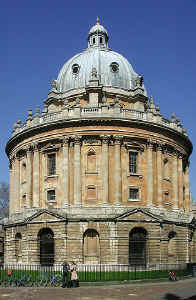|
The Radcliffe Camera is a
library, built in 1737-49 with money left by Dr Radcliffe. The architect
was James Gibbs. He adopted the concept of a rotunda which had originally
been proposed by Hawksmoor.
The ground floor is
rusticated; smooth, wide-jointed blocks. There are eight large arched and
pedimented bays all originally open - till 1863 - and eight intermediate
bays with niches. ... The upper floor has coupled Corinthian columns, and
the bays now alternate between windows and niches. Both are in two tiers.
The large windows have pediments, the small ones lugs top and bottom. This
is similar in the bays of the niches. Top with balustrade
and balls, and then the drum with the dome, which is the chief distinctive
mark of the Oxford skyline. The drum has windows between buttress piers,
and the dome - not of stone - is more elongated than that of
St. Paul's, i.e. rather of the St. Peter's type. Pronounced ribs, small
lantern.
John Summerson has written ( in
Architecture in Britain 1530-1830, Yale University Press):
Essentially Mannerist is the treatment of the Corinthian order, whose
coupled columns separate alternate wide and narrow bays, the difference in
width being, however, purposely ambiguous. Again, above the order, the
buttresses of the dome come down between and not over the pairs of
columns, and yet the bays in which they are occur are precisely not
the bays which are strengthened by forward breaks in the rusticated base.
Moreover, these emphatic units in the base line up with only one of
each pair of columns in the bay above them. The rhythms of the whole
structure are thus extremely complicated. No emphasis falls just where you
would expect it; everything is syncopated. Very rarely in English
architecture has the spirit of Mannerism been so pronounced" |
|




